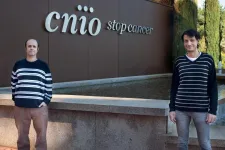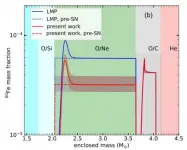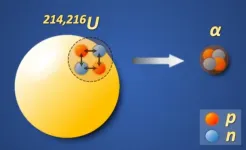INFORMATION:
Notes to editors:
* Associate Professor Haolan Xu is an ARC Future Fellow at UniSA's Future Industries Institute.
* A selection of papers related to this research can be viewed here. For further details or access to a specific paper, please use the media contact below.
Media: Dan Lander | mobile: 0408 882 809 | email: dan.lander@unisa.edu.au
Sunlight to solve the world's clean water crisis
2021-04-16
(Press-News.org) Researchers at UniSA have developed a cost-effective technique that could deliver safe drinking water to millions of vulnerable people using cheap, sustainable materials and sunlight.
Less than 3 per cent of the world's water is fresh, and due to the pressures of climate change, pollution, and shifting population patterns, in many areas this already scarce resource is becoming scarcer.
Currently, 1.42 billion people - including 450 million children - live in areas of high, or extremely high, water vulnerability, and that figure is expected to grow in coming decades.
Researchers at UniSA's Future Industries Institute have developed a promising new process that could eliminate water stress for millions of people, including those living in many of the planet's most vulnerable and disadvantaged communities.
A team led by Associate Professor Haolan Xu has refined a technique to derive freshwater from seawater, brackish water, or contaminated water, through highly efficient solar evaporation, delivering enough daily fresh drinking water for a family of four from just one square metre of source water.
"In recent years, there has been a lot of attention on using solar evaporation to create fresh drinking water, but previous techniques have been too inefficient to be practically useful," Assoc Prof Xu says.
"We have overcome those inefficiencies, and our technology can now deliver enough fresh water to support many practical needs at a fraction of the cost of existing technologies like reverse osmosis."
At the heart of the system is a highly efficient photothermal structure that sits on the surface of a water source and converts sunlight to heat, focusing energy precisely on the surface to rapidly evaporate the uppermost portion of the liquid.
While other researchers have explored similar technology, previous efforts have been hampered by energy loss, with heat passing into the source water and dissipating into the air above.
"Previously many of the experimental photothermal evaporators were basically two dimensional; they were just a flat surface, and they could lose 10 to 20 per cent of solar energy to the bulk water and the surrounding environment," Dr Xu says.
"We have developed a technique that not only prevents any loss of solar energy, but actually draws additional energy from the bulk water and surrounding environment, meaning the system operates at 100 per cent efficiency for the solar input and draws up to another 170 per cent energy from the water and environment."
In contrast to the two-dimensional structures used by other researchers, Assoc Prof Xu and his team developed a three-dimensional, fin-shaped, heatsink-like evaporator.
Their design shifts surplus heat away from the evaporator's top surfaces (i.e. solar evaporation surface), distributing heat to the fin surface for water evaporation, thus cooling the top evaporation surface and realising zero energy loss during solar evaporation.
This heatsink technique means all surfaces of the evaporator remain at a lower temperature than the surrounding water and air, so additional energy flows from the higher-energy external environment into the lower-energy evaporator.
"We are the first researchers in the world to extract energy from the bulk water during solar evaporation and use it for evaporation, and this has helped our process become efficient enough to deliver between 10 and 20 litres of fresh water per square metre per day."
In addition to its efficiency, the practicality of the system is enhanced by the fact it is built entirely from simple, everyday materials that are low cost, sustainable and easily obtainable.
"One of the main aims with our research was to deliver for practical applications, so the materials we used were just sourced from the hardware store or supermarket," Assoc Prof Xu says.
"The only exception is the photothermal materials, but even there we are using a very simple and cost-effective process, and the real advances we have made are with the system design and energy nexus optimisation, not the materials."
In addition to being easy to construct and easy to deploy, the system is also very easy to maintain, as the design of the photothermal structure prevents salt and other contaminants building up on the evaporator surface.
Together, the low cost and easy upkeep mean the system developed by Assoc Prof Xu and his team could be deployed in situations where other desalination and purification systems would be financially and operationally unviable.
"For instance, in remote communities with small populations, the infrastructure cost of systems like reverse osmosis is simply too great to ever justify, but our technique could deliver a very low cost alterative that would be easy to set up and basically free to run," Assoc Prof Xu says.
"Also, because it is so simple and requires virtually no maintenance, there is no technical expertise needed to keep it running and upkeep costs are minimal.
"This technology really has the potential to provide a long-term clean water solution to people and communities who can't afford other options, and these are the places such solutions are most needed."
In addition to drinking water applications, Assoc Prof Xu says his team is currently exploring a range of other uses for the technology, including treating wastewater in industrial operations.
"There are a lot of potential ways to adapt the same technology, so we are really at the beginning of a very exciting journey," he says.
ELSE PRESS RELEASES FROM THIS DATE:
New radiotracer safe and effective for imaging early rheumatoid arthritis
2021-04-16
Reston, VA--New research shows that a novel positron emission tomography (PET) tracer that targets inflammation is safe and can clearly identify early stages of rheumatoid arthritis. The promising PET tracer, 68Ga-DOTA-Siglec-9, rapidly clears from blood circulation, has a low radiation dose, and can be easily produced. This first-in-human study was published in the April issue of the Journal of Nuclear Medicine.
Inflammation is a significant part of several chronic diseases, including rheumatoid arthritis and its related issues. While PET imaging with 18F-FDG is a valuable tool for the diagnosis and monitoring of the effects of treatments, it is not specific enough to assess inflammation.
"It's important to detect inflammation early so that patients ...
Patients of women doctors more likely to be vaccinated against the flu
2021-04-16
New UCLA research suggests that elderly patients of female physicians are more likely than those of male physicians in the same outpatient practice to be vaccinated against the flu.
This trend holds for all racial and ethnic groups studied and could provide insight into improving vaccination rates for influenza, COVID-19 and other illnesses, according to the research letter, which is published in the peer-reviewed JAMA Internal Medicine.
Prior studies have shown that female physicians tend to spend more time with their patients, said study author Dr. Dan Ly, an assistant professor in the division of general internal medicine and health services research at the David ...
Tiny cat-sized stegosaur leaves its mark
2021-04-16
A single footprint left by a cat-sized dinosaur around 100 million years ago has been discovered in China by an international team of palaeontologists.
University of Queensland researcher Dr Anthony Romilio was part of the team that investigated the track, originally found by Associate Professor Lida Xing from the China University of Geosciences (Beijing).
"This footprint was made by a herbivorous, armoured dinosaur known broadly as a stegosaur - the family of dinosaurs that includes the famed stegosaurus," Dr Romilio said.
"Like the stegosaurus, this little dinosaur probably had spikes on its tail and ...
Rural-urban divide compounds racial disparities in COVID-19 deaths, study finds
2021-04-16
While Black, Hispanic, Latino, Indigenous, Asian and Pacific Islander people are more likely to die of COVID-19 than white people nationwide, a recent study from Oregon State University found the risk was even greater for racial and ethnic minority groups living in rural areas compared with urban areas.
To address the disparities, researchers say the health care response to COVID-19, including the vaccine rollout, needs to allocate additional resources to rural areas that have been hardest hit, especially those where minority populations are concentrated.
Earlier studies throughout the U.S. have shown that ...
Oregon scientists create mechanism to precisely control soundwaves in metamaterials
2021-04-16
EUGENE, Ore. -- April 16, 2021 -- University of Oregon physicists have developed a new method to manipulate sound -- stop it, reverse it, store it and even use it later -- in synthetic composite structures known as metamaterials.
The discovery was made using theoretical and computational analysis of the mechanical vibrations of thin elastic plates, which serve as the building blocks for the proposed design. The physicists, Pragalv Karki and Jayson Paulose, also developed a simpler minimal model consisting of springs and masses demonstrating the same signal manipulation ability.
"There have been a lot of mechanisms that can guide or block the transmission of sound waves through a metamaterial, but our design is the first to dynamically stop and reverse a sound pulse," said Karki, ...
Coronavirus does not infect the brain but still inflicts damage
2021-04-16
NEW YORK, NY (April 16, 2021)--SARS-CoV-2, the virus that causes COVID-19, likely does not directly infect the brain but can still inflict significant neurological damage, according to a new study from neuropathologists, neurologists, and neuroradiologists at Columbia University Vagelos College of Physicians and Surgeons.
"There's been considerable debate about whether this virus infects the brain, but we were unable to find any signs of virus inside brain cells of more than 40 COVID-19 patients," says James E. Goldman, MD, PhD, professor of pathology & cell biology (in psychiatry), who led the ...
CNIO researchers explain the toxicity of USP7 inhibitors, under development for cancer treatment
2021-04-16
Understanding the components that control cell division is fundamental to understanding how life works and how alterations in this delicate process can cause diseases such as cancer. It was precisely the discoveries of "key regulators of the cell cycle" and their implications for processes such as cancer, that won the British scientists R. Timothy Hunt and Paul M. Nurse and the American scientist Leland H. Hartwell the 2001 Nobel Prize in Physiology or Medicine. A study led by Óscar Fernández-Capetillo, Head of the Genomic Instability Group at the Spanish National Cancer Research Centre (CNIO) and published this week in The EMBO Journal uncovers a new cell cycle control element, the USP7 protein. It acts as a brake to prevent cells ...
Study sheds light on stellar origin of 60Fe
2021-04-16
Researchers from the Institute of Modern Physics (IMP) of the Chinese Academy of Sciences and their collaborators have recently made great progress in the study of the stellar beta-decay rate of 59Fe, which constitutes an important step towards understanding 60Fe nucleosynthesis in massive stars. The results were published in Physical Review Letters on April 12.
Radioactive nuclide 60Fe plays an essential role in nuclear astrophysical studies. It is synthesized in massive stars by successive neutron captures on a stable nucleus of 58Fe and, during the late stages of stellar evolution, ejected into space via a core-collapse supernova.
The characteristic gamma lines associated with the decay of 60Fe have been detected by space gamma-ray detectors. By comparing the 60Fe ...
A rich marine algal ecosystem 600 million years earlier than previously thought
2021-04-16
The first photosynthetic oxygen-producing organisms on Earth were cyanobacteria. Their evolution dramatically changed the Earth allowing oxygen to accumulate into the atmosphere for the first time and further allowing the evolution of oxygen-utilizing organisms including eukaryotes. Eukaryotes include animals, but also algae, a broad group of photosynthetic oxygen-producing organisms that now dominate photosynthesis in the modern oceans. When, however, did algae begin to occupy marine ecosystems and compete with cyanobacteria as important phototrophic organisms?
In a new study Zhang et al use the molecular remains of ancient algae (so-called biomarkers) to show that algae occupied an important ...
Scientists report remarkable enhancement of α-particle clustering in uranium isotopes
2021-04-16
It is always exciting to find new isotopes with extreme neutron/proton numbers in nuclear physics research. In the region of heavy nuclei, α-decay is one of the pervasive decay modes and plays an essential role in searching for new isotopes. However, even after about a century of studying α-decay, scientists still cannot perfectly describe how the α-particle is formed at the surface of the nucleus before its emission.
In the α-decay process, the α-particle can be regarded not only as two protons plus two neutrons, but also as two proton-neutron pairs. Although previous studies have proved the importance of the pairing forces between the identical nucleons, it remains unclear whether ...






